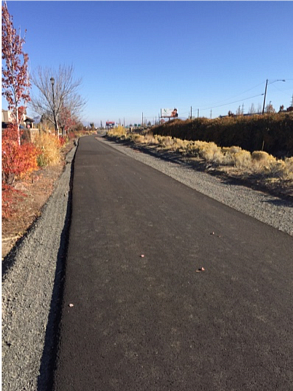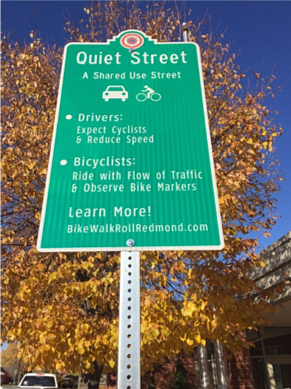In the fall of 2015, Sustainable City Year Program students headed to Redmond to begin a partnership that would last throughout the school year. Redmond is a town of 25,000 residents, located 2.5 hours from campus in the high desert of Central Oregon. Four hundred students worked alongside a variety of city departments and partners on 24 different projects, developing concepts and ideas for a sustainable future in Redmond. Today, many of those recommendations are coming to fruition.
The first set of implemented projects from the SCYP-Redmond partnership focuses on making it easier and more comfortable for people to walk and bike more frequently. Redmond wants to build one of the nation’s premier family friendly biking network that takes advantage of its pleasant weather, level landscape, natural beauty, and existing off-street infrastructure. Many of the ideas generated by SCYP students were adopted within the first few months of 2016, and today those ideas are coming to fruition.

One of Redmond’s new efforts prioritizes the addition of sidewalks and bike lanes to many of its current construction projects. For example, South Canal Boulevard,one of the city’s largest arterials, previously completely lacked any pedestrian or bicycle facilities. Now, when the current improvement project is complete, sidewalks and bike lines will line both sides of the road. Separately, a multi-purpose asphalt path has been constructed alongside the Homestead Canal throughout the heart of Redmond. The project is scheduled for completion in the spring of 2019 and represents two key insights that emerged throughout the partnership. The path creates a family-friendly environment for walking and biking protected from cars and connects the system of such paths so that residents can access the community at large.

Redmond has also improved bike infrastructure on its existing streets through the introduction of Quiet Streets. On these roads, the city has lowered vehicle speed limits, painted sharrows on the roadway, and increased wayfinding signage. These efforts signify to both vehicles and cyclists that the street is intended for shared use. Quiet Streets encourage local residents to commute by bicycle, particularly in a city that receives 200 days of sunlight per year. These measures follow student recommendations to take advantage of lower car-volume residential streets by elevating their design and comfort for bicyclists.
Finally, Redmond is working with local schools to increase the number of safe, non-vehicular routes to school for local students – a clear indicator about its desire to be a family-friendly community. Currently, many of the streets around Redmond’s schools do not accommodate non-vehicular forms of traffic increasing stress for many parents whose children to walk or bike to school. The city is partnering with local schools to improve walking and biking conditions for students, and is currently conducting an online survey complete with an interactive map. As the survey results are returned and feedback is gathered from the other new infrastructure projects, Redmond officials expect to act strategically and holistically, enabling more children access school independently.
Redmond is both an exemplar and a typical example of what happens in an SCYP partnership. Of course, Redmond is a special place with incredibly dedicated staff, local officials, and community members who take pride in their family-friendly and welcoming community. Redmond is typical in that the ideas students produced throughout the yearlong partnership were both aspirational and implementable, yet remained unique to the Redmond community. We are thrilled to see the ambition towards a sustainable future displayed during the partnership translated into practical infrastructure accessible to the whole community. We look forward to Redmond’s continued progress towards a more sustainable future!
